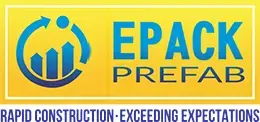The prefab industry is experiencing remarkable growth, fueled by several captivating trends that are paving the way for its future. In this article, we explore five noteworthy trends that are set to define the industry in 2023.
Sustainability: Embracing Environmental Responsibility:
In an era where environmental consciousness is paramount, prefab buildings hold a significant advantage over their traditional counterparts. With reduced energy consumption and material requirements, prefabricated structures offer inherent sustainability benefits. This trend is poised to gain even greater prominence as businesses and consumers increasingly recognize the environmental impact of their choices.
Customization: Shaping Buildings to Unique Needs:
Gone are the days of standardized prefab designs. Thanks to remarkable technological advancements, prefab builders now offer an unparalleled level of customization. This empowers customers to craft buildings that precisely align with their specific requirements and preferences, fostering a sense of individuality and purpose.
Offsite Construction: Enhancing Efficiency and Quality:
Offsite construction, a process where buildings are meticulously fabricated in controlled factory environments before being transported to their final location, is rapidly gaining traction. This approach enables superior quality control and reduces construction time, making it a highly efficient alternative to traditional on-site construction.
Modular Construction: Adapting with Agility:
Modular construction, a subset of offsite construction, empowers the creation of prefabricated buildings through the assembly of modules on-site. This method offers remarkable flexibility, allowing structures to be tailored and scaled to cater to specific needs. The adaptability of modular construction ensures a seamless integration of prefabricated elements with diverse architectural visions.
3D Printing: A Technological Paradigm Shift:
The remarkable progress in 3D printing technology has the potential to revolutionize the prefab industry. Leveraging 3D printers, complex and intricate structures can be fabricated that were previously inconceivable using conventional construction methods. This cutting-edge approach opens up a world of possibilities for architects and builders to bring their most innovative and imaginative designs to life.
Business Benefits:
These emerging trends bring a multitude of benefits to businesses operating within the prefab industry:
- Sustainability practices contribute to a reduced environmental footprint and can enhance a company’s reputation, attracting environmentally-conscious customers and positively impacting the bottom line.
- Customization capabilities enable businesses to deliver tailor-made solutions that precisely meet the unique needs and preferences of their clientele, enhancing customer satisfaction and loyalty.
- The efficiency and quality control offered by offsite construction streamline the building process, saving businesses valuable time and resources.
- Modular construction grants businesses the flexibility to adapt to changing requirements, ensuring their structures remain versatile and adaptable over time.
Embracing 3D printing technology provides businesses with the means to create awe-inspiring, intricate structures, fostering innovation and setting them apart from competitors.
Getting Involved in the Prefab Industry:
- For businesses seeking to engage in the prefab industry, several avenues can be explored:
- Investing in prefab companies offers exposure to the industry’s promising growth potential, allowing businesses to capitalize on its upward trajectory.
- Partnering with prefab builders provides access to specialized expertise and capabilities, facilitating the integration of prefab solutions into existing operations or project collaborations.
- Developing proprietary prefab products or services allows businesses to cater to the growing demand for prefab solutions, positioning them as leaders and innovators in the industry.
Conclusion:
The prefab industry is undergoing rapid evolution, driven by these transformative trends. By embracing these trends and actively participating in the industry, businesses can position themselves to harness the abundant growth opportunities that lie ahead. As the industry continues to flourish, expect to witness remarkable innovations and pioneering developments in the prefab landscape.











